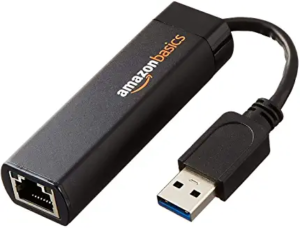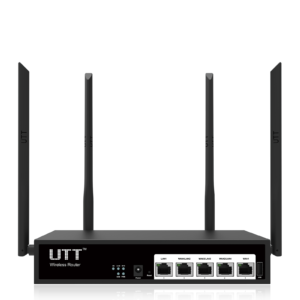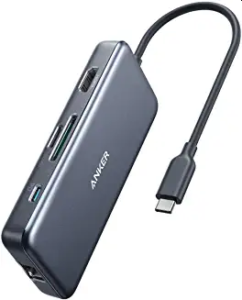
This article talks about things that you can do in your home to get the best possible work-from-home results.
Don’t use wifi. A first tip for best work-from-home results is to avoid the use of wifi unless there is absolutely no other choice.
 I am overstating things only slightly when I say that Wifi uses portions of the radio spectrum that are “unlicensed” by the FCC. In these portions of the radio spectrum it is the “wild wild West”. Anybody can do almost anything in these portions of the radio spectrum and there is little or nothing you can do about it. You could have a wifi access point set up in your home that works fine on Monday. And then on Tuesday your geographically nearby neighbors could plug in fancy new wifi access points in their homes, access points with as many as six antennas sticking up. See for example the UTT router I recommended to you back in 2017 (blog article). Your adjacent neighbors could read my blog article from 2017, plug in these UTT routers (photo at right), and their wifi signals would overwhelm your wifi signals.
I am overstating things only slightly when I say that Wifi uses portions of the radio spectrum that are “unlicensed” by the FCC. In these portions of the radio spectrum it is the “wild wild West”. Anybody can do almost anything in these portions of the radio spectrum and there is little or nothing you can do about it. You could have a wifi access point set up in your home that works fine on Monday. And then on Tuesday your geographically nearby neighbors could plug in fancy new wifi access points in their homes, access points with as many as six antennas sticking up. See for example the UTT router I recommended to you back in 2017 (blog article). Your adjacent neighbors could read my blog article from 2017, plug in these UTT routers (photo at right), and their wifi signals would overwhelm your wifi signals.
So if you are smart, you will avoid use of wifi for your desktop or notebook computer. You will use a wired ethernet connection.

If your notebook gets its power on a USB C connector (blog article) then what’s smart is to use that connector not only to power your computer but also to provide an ethernet port for your Internet connection. Then put your notebook computer into “airplane mode”. You will cease to be at risk of abrupt changes in your wifi environment. My favorite adapter for this purpose is the fetchingly named Anker AK-A83520A1 adapter (Amazon link) shown at right.
If your notebook gets its power the old-fashioned way, on a dedicated proprietary power plug, then my favorite approach is the Amazon Basics USB-to-ethernet adapter (Amazon link) shown at the top of the article.
As mentioned below, the ethernet connections in your home could be as slow as “ten” megabits per second and it would probably work just fine for you. But the two adapters mentioned above are gigabit adapters and it frankly does not cost anything extra these days to get an ethernet adapter that runs at gigabit speed. So make sure that the adapter you purchase and use is a gigabit ethernet adapter.
Do you need gigabit ethernet? Ethernet devices are available that can work at ten megabits per second, a hundred megabits per second, and a gigabit per second. Yes of course if you want better faster more power! like Tim the Toolman Taylor in Home Improvement, you will want a gigabit connection to the Internet from your ISP and you will want gigabit ethernet throughout your home. But dear readers you have my permission to use slower ethernet for your work-at-home computer and your work-at home VOIP telephone that is connected to your office phone system. I promise you that “hundred” or even “ten” ethernet will be more than adequate for your work-at-home computer and your work-at home VOIP telephone. The connection from your WFH computer to your office resources will have many bottlenecks along the way, and the ethernet in your home will not be the slowest segment even if it is mere “ten” ethernet.
Still if you have the ability to do it I suggest trying hard to have at least “hundred” ethernet around your home. And yes of course if it happens to be that you can get gigabit ethernet working around your home, that’s great.
What Internet speed do you need from your ISP? From your work-from-home computer, run the Oppedahl Patent Law Firm LLC speed test. Are your download and upload speeds both faster than at least one megabit per second? Is your ping time less than 100 milliseconds? Is your jitter less than 100 milliseconds? Then I predict your work-from-home VOIP phone will work just fine, or to say it differently, to the extent that your WFH phone is not working fine, the cause of it failing to work well is nothing over which you will be able to have any personal control. And I predict your work-from-home computer will work just fine, or to say it differently, to the extent that your WFH computer is not working fine, the cause of it failing to work well is nothing over which you will be able to have any personal control.
Having said all of this, in these trying times you will not be the only customer of your ISP in your neighborhood. Your neighbors will during these trying times be sucking up data from the ISP even more than you are. They will be binge-watching the 26 episodes of the series Better off Ted which by the way I recommend as an escape during these trying times. Your ISP will be allocating bandwidth as best it can among the many customers in your neighborhood. If you change your data plan to a faster data plan then this may prompt your ISP to favor you a bit in the bandwidth juggling. Maybe you followed my suggestion in February of 2018 (blog article) to get gigabit Internet in which case you are already doing the best that you can.
Do not use satellite Internet. If your way of connecting to the Internet is a satellite connection, then my heart goes out to you. Your life will be miserable. Your VOIP phone is already disappointing you and your VPN to the office will be slow as molasses, to use the technical term. If you can find any other way to connect, use that other way.
Use a stand-up desk. Yes I realize this is not really an Internet tip. But if you can do it, purchase and use a desk that can work as a normal chair-type desk and that can also be a stand-up desk. You spine will thank you for it.
Use Mindfulness-Based Stress Reduction. See this blog article.
Comments. Please post a comment below with your tips. And do you have strong feelings as to whether the speed test numbers that I stated above are reasonable (one and one and a hundred and a hundred) thresholds for adequately functioning VOIP and office VPN connections?
